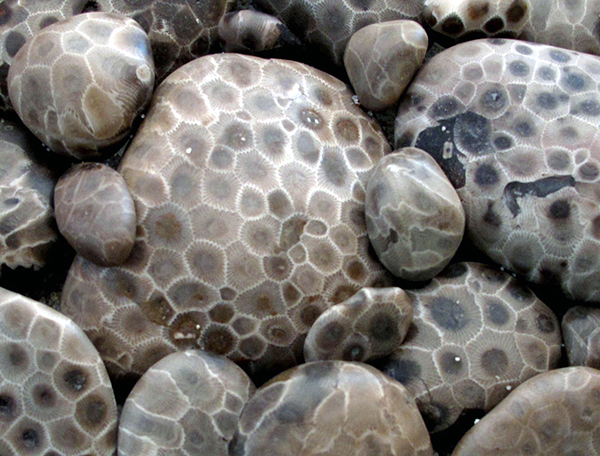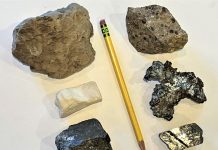
Story by Bill Vossler
At 350 million years of age, Petoskey stones are older than the dinosaurs, which roamed the earth beginning 165 million years ago. Like dinosaurs, Petoskey stones are rocks and fossils (The Complete Guide to Petoskey Stones, Bruce Mueller and William H. Wilde, 2004). Though evidence of dinosaurs can be found almost everywhere around the world, it is not so with Petoskey stones. Mostly, they are found in Michigan, though some show up in Illinois, Indiana, and Iowa.
Petoskey stones began life as coral planulae, free-swimming larva that propel themselves around in the warm waters of tropical seas with tiny hairlike projections. Eventually, they drop to the bottom of the sea. There, they anchor onto something solid and progress into the polyp stage, growing and dividing, making exact copies. To protect themselves, they secrete calcite to make a hard, cuplike outer covering, or exoskeleton, say Mueller and Wilde. Like a snail, the soft-bodied coral lives inside the hard exoskeleton and uses its tentacles to snatch food that drifts by.
During the ancient Devonian Period of the Paleozoic Era (ca. 350 million years ago), these living coral existed in a warm, shallow, saltwater sea filled with other marine life. At that time, today’s Michigan was actually located far south, near the earth’s equator.
These hexagonaria percarinata corals—the only variety that forms Petoskey stones—thrived in tropical reefs, according to www.petoskeyarea.com, until “the earth’s tectonic plates moved, pushing Michigan northward and above sea level, until it reached today’s 45th parallel, creating dry land formations.”

In the process, skeletons of these tightly packed, six-sided corallites became fossilized, forming Petoskey stones. Their distinctive dark centers, called “eyes”, were actually the mouths of the coral. The distinctive lines surrounding the eyes that make the stones so attractive were once tentacles that brought food into the mouth (Petoskeychamber.com).
The movement of the tectonic plates buried the fossils deeply. Subsequent weathering wore down the overburden and helped bring them closer to the surface. Some 70,000 years ago, The Laurentide Ice Sheet, two miles thick in places, ground pieces off the original coral formation (c. 90,000 and 20,000 years ago) and spread them around lower Michigan. According to The Complete Guide, “The glacier picked up the coral colonies that had weathered to the surface, froze to them, and incorporated them within its body, and carried them south. In the northern quarter of the state the glacier gouged out and freed billions or trillions more from the calcareous shales in which they were entombed. As the glacier moved across the state, it left tremendous numbers of coral colonies scattered across Michigan and undoubtedly carried some into Illinois, Indiana and Iowa. When the ice melted, the Petoskeys were left behind as glacial erratics, stones carried by the glacier to places where they don’t belong.”
During the process of being dug out and carried over bedrock by the glaciers, many of the Petoskey stones became rounded off. The enormous weight of the ice also scratched some and completely crushed others. Today, wave action continues to round their contours, often to the size and shape of an oval bar of soap. Those that are not found in or near water, and therefore haven’t been subjected to the tumbling action of the waves, are less rounded and come in much more irregular shapes (The Complete Guide).
Petoskey Lore
Legend has it that, in 1787, an Ottawa Indian chief named Neatooshing and his pregnant wife were camping out near the Kalamazoo River in southwestern Michigan. During the night, the cry of a newborn baby was heard, and in the morning, the rising sun’s rays reflected off the new son‘s eyes, causing the chief to say, “His name shall be Petosegay. He shall become an important person.”

“Bedosegay” and “Pet-O-Sega” are variants of the same name, which in English means “rising sun”, “rays of dawn”, or “sunbeams of promise”, which the chief saw reflected off his newborn son’s eyes. Eventually, Pet-O-Sega became anglicized to “Petoskey”.
The baby did live up to his father’s prediction that he would become important in at least four different ways, first, as a wealthy fur trader. Second, just before his death in 1873, a city in the northwestern part of the Lower Peninsula was named after him.
At some unknown time, a third distinction was bestowed upon the subject of the long-ago prophecy when stony fossils became named “Petoskey stones”. The six-sided coral formations filled with radiating lines may be reminiscent of the sun shining off the newborn’s eyes, but they were probably named because they are found in quantity near Petoskey, Michigan.
Fourth, the child-man became important because these Petoskey stones were declared the official state stone. Governor George Romney signed the single-sentence Act 89 of 1965 on June 28, 1965, in the presence of Ella Jane Petoskey, the only living grandchild of Chief Petosegay.
It was not until 1969 that geologist Dr. Edwin C. Stumm established that this “stone” was actually fossilized colonial coral of the genus and species Hexagonaria percarinata, in which organic components had been replaced by calcite, silica, and other minerals.
Kathy Miling, of Nature’s Treasures (www.getpetoskeystones.com), says, “The Petoskey stone is loved by all, whether they’re 2 or 80, because of the fascinating and striking honeycomb pattern that varies in shades of browns and blacks, with dividing lines of white. Each one is uniquely different, with imperfections that give them some character. I have hunted them for years. It is exciting every time you find one on the beaches of Lake Michigan or on the river banks.”

Miling says she started her website with information and photos about the fossil rocks because she loved Petoskey stones. But she received so many hits, she decided to start buying and selling them. Many people who buy Petoskey stones from her do so to have a souvenir from their trip to Michigan or because they moved away and want one to remind them of their days of hunting the Petoskey stone when they were young.
Official White House photos show that President Barack Obama had a Petoskey stone on his desk in the Oval Office that was given to him as a gift. He often tapped it with a finger.
Average Petoskey stones can be collected for their beauty, says Miling. “Because the coral was red when it was a live plant, today you can still see red in a few of them, which adds to their beauty. Maybe one in every 100.”
Their beauty can also enhanced by polishing them with sandpaper, starting with a coarse grade, then moving to finer ones, and eventually using very fine steel wool or wet/dry sandpaper to smooth out the larger sanding marks.
According to wmich.edu, the stone should be finished with leather or cloth soaked in oil. Despite its silica content, Petoskey stone is too soft to be put in a rock tumbler; it will be damaged.
In addition to self-collecting specimens, Olson says Petoskey stones can be purchased all over the city of Petoskey and on the Internet.
Miling adds, “The Petoskey stone is very soft, with a Mohs hardness of 5. However, it has been cut, shaped, carved and polished by lapidary artists into many items, from jewelry to paperweights, door stops, book ends and chimes. There are also artists that carve them into shapes of all kinds.”
Though Miling’s site does not make any claims for different powers that Petoskey stones might have, some sites say they prevent naughty spirits from interfering in one’s life, enhance awareness of emotions, clear negative energies, bring hope, and aid creativity and healthiness, among many other claims.
The most obvious benefit they bestow is the joy in their unique, collectible beauty.

Where to Collect
This fossil coral is found only in the Alpena Limestone rock strata, a mixture of limestones and shales that is part of the Traverse Group of Devonian Age. That makes them distinctive, as the outcrops of these rocks that contain Petoskey stones are restricted to the Little Traverse Bay near Petoskey.
Petoskey stones can be found in many places in the area, but first the collector has to know what to look for. Dry Petoskey stones often are light- to dark-gray and look like ordinary limestone. Not until the stone is wet does the distinctive, six-sided “rays of the rising sun” pattern pop out. That means it’s easier to find Petoskey stones along the wave-washed stretches of beach or by wading in the water and searching for them. A spray bottle of water serves the same purpose when you’re hunting in dry areas.
Michigan collectors have a number of collecting spots for Petoskey stones. Not surprisingly, one of them is Petoskey State Park, with easy access to two miles of shoreline on Little Traverse Bay and Lake Michigan where they can be hunted and found. A recreation passport is required for entry to this 303-acre park, located between Petoskey and Harbor Springs, off state Route 119.
Other collecting areas in Petoskey include Magnus City Park Beach, a 1,000-foot-long beach that is easily accessed at the waterfront, and Bay Front & Sunset Park, which is within walking distance from downtown, and near the marina.
While the lakeshore is the most popular hunting ground for Petoskey stones, don’t forget the glacial action that carried them from their place of origin, spreading them around the local area. They can also be found in road cuts, gravel pits, and fields. Collectors must get permission from landowners and quarry operators before attempting to collect on private land.
Some claim that Petoskey stones can be found on some Lake Huron beaches, on the east side of the peninsula. Outside of Michigan, Petoskey stones can be found in Midwest states such as Indiana, Illinois and Iowa. Falls of the Ohio State Park, located in Clarksville, Indiana, has 220 acres of exposed Devonian-age fossil beds.
Other varieties of corals also flourished in that Devonian sea and were similarly preserved. These “fake” Petoskey stones are deceiving, as most people would not be able to identify these other types of corals. True Petoskey stones, however, consist only of the fossils of hexagonaria percarinata corals. False Petoskey stones found in Indonesia can be differentiated from the real thing because the eyes are much smaller, almost like baby Petoskey stones. The rays in the center of the hexagons are also lighter, and don’t always attach to the center.















